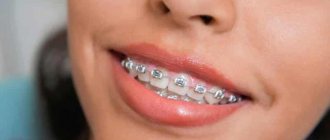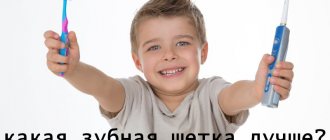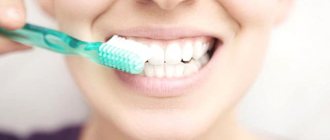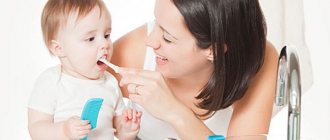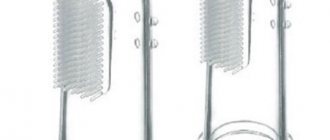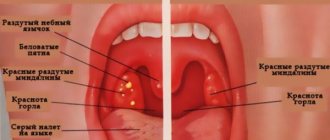Many young parents do not even suspect that the wrong pacifier and even the innocent habit of a baby sucking a finger can lead to improper bite formation. Let's look at the main causes of malocclusion at an early age, as well as measures to help prevent such a defect. One such device is a pacifier for correcting malocclusion. Particular attention must be paid to compliance with hygiene rules and the use of specialized products.
What is an orthodontic pacifier?
The main feature of this nipple is its shape - part of it is beveled and flattened, which corresponds to a more natural position in the child’s mouth. Why did they do this? According to these parameters, it corresponds to the anatomical shape of the mother's breast when feeding the baby. This is how you can achieve the most correct grip with your mouth, as well as the desired formation of your bite.
What is an orthodontic pacifier used for? Like any other pacifier, it is given to the child to calm him down, stop crying, and whims. But due to its shape, it also additionally stimulates the development of the jaw apparatus, strengthens joints and has a positive effect on the position of future teeth.
Measures to prevent malocclusion
Correcting malocclusion is much more difficult than preventing it. Parents need to know the following measures to prevent malocclusion:
- The expectant mother should protect herself from even the slightest cold.
- In the fifth month of pregnancy, the child begins the process of developing teeth, so calcium and fluoride must be present in the mother’s diet.
- Scrupulously follow your pediatrician's instructions regarding infant feeding, especially if breastfeeding is impossible.
- Make sure your child breathes through his nose. Otherwise, you need to consult a doctor to exclude the possibility of diseases of the respiratory system.
- In the early stages, the child should be weaned from thumb sucking and prolonged use of a pacifier.
- Approach with full responsibility the choice of an orthodontic pacifier and pacifier.
How to make a choice?
When entering a store that sells baby products, it’s easy for new parents to get confused. After all, the offer of even just pacifiers represents a huge number of models, colors, sizes, materials, etc. Let’s try to determine what you need to pay attention to when choosing a baby pacifier for the first time:
- The material from which its main part is made is the one that the baby will directly suck on. Recently, manufacturers have settled on two options - latex and silicone. The first is more natural, but has a slight aftertaste that some children do not like. The second one has hypoallergenic characteristics, is colorless and odorless, elastic and lasts longer.
- The shape of the nipple can also be different - round, beveled, flat, etc. We point out that the orthodontic one is the most acceptable, since it completely follows the shape of the breast and best matches the natural position of the child’s tongue and jaws.
- The size of the pacifier is important - you need to pay attention to the age of the baby for whom it is intended, indicated on the label. So, they are usually divided for children up to six months, up to one year and up to two or three years. It is obvious that even if you buy a pacifier of the correct shape, but a larger or smaller size, you will harm the development of the bite.
- Color - here the choice remains only with the parents, since for the baby it will not matter yet. The only thing doctors pay attention to is the wish that it be light, neutral tones. After all, a bright object in the child’s visibility range can distract his attention.
- The price of such products fluctuates approximately in the same ranges and differs only depending on the brand, brand, and popularity of the manufacturer.
There are also nipples for bottles of different shapes, including orthodontic ones. If your baby will be fed formula, then it makes sense to choose it according to the specified parameters. This is the only way to be sure that many dental and speech therapy problems will be avoided in the future.
Separately, it is worth pointing out the duration of use of pacifiers made of different materials. Silicone ones are resistant to temperature changes and last much longer. Although over time they may begin to crack and lose elasticity. Latex ones are more fragile, a child can easily bite through them. In addition, such products often begin to stick together and need to be replaced with new ones.
At what age should you teach
You can try to connect a baby with a pacifier as early as one month of age, when he cannot yet separate the pacifier and the mother's breast. It’s worth starting with the simplest model – the Soviet “daisy”. As practice shows, among the many fashionable pacifiers, most children choose this one.
If the first acquaintance ended in failure, the baby tried to spit out an incomprehensible object, then postpone this process for a couple of weeks, or even a month, and try again.
If your child categorically refuses a pacifier for 6-7 months, then stop torturing each other, then there is no place for a pacifier in your home.
Popular models
In the store you can find the following famous brands:
- Avent (Avent) - silicone products are odorless and tasteless. Specially shaped wings reduce pressure on the child’s gums and are considered a very convenient option. Manufacturers have thought through ensuring daily hygiene by creating a separate cap for each product. They can also be washed in the dishwasher or sterilized in special devices.
- Bibi (Bibi) - there are varieties of latex and silicone models. Clever holes on the wings of the base are designed for better air circulation, which prevents irritation of the skin around the mouth. The quality of the products is such that they do not deteriorate when repeatedly boiled. What parents will especially like is the opportunity to choose interesting and original colors with inscriptions or drawings.
- NUK (Nuk) - the nipple is made from a particularly soft material, and its shape has a good recess, which provides space for the tongue. Sizes are designed for children from toddlers to three years old. Made of latex in such color options as gold, red and blue.
- Dr.Brown (Doctor Brown) - silicone models without taste or smell. The manufacturer offers to purchase a set of two products at once. The comfortable shape and pleasant material help the child quickly get used to the device and happily accept it. The sizes are larger for newborn babies.
- Tommee tippee (Tommy tippee) - silicone models with an emphasis on breathable wings at the base. It is thanks to them that it is easy for the child to hold the pacifier in his mouth and at the same time the skin does not become irritated from increased salivation. Parents will also like the original design and colors.
- Canpol (Kenpol) - the manufacturer offers the widest range of nipples made of latex and silicone. At the same time, various shapes, colors, sizes will help you choose the most suitable one for your baby.
Useful tips
In addition to the criteria for making the right choice, parents need to know how to give this hygiene device to their child. A reasonable approach will eliminate the likelihood of undesirable consequences:
- Before your baby gets acquainted with the device for the first time, it is necessary to boil (sterilize) the pacifier. This will prevent the development of infectious diseases of the oral cavity;
- After 4 - 6 weeks of operation, you need to replace the old device with a new one. If the pacifier is made of latex, it needs to be changed much more often;
- For safe use of the pacifier, you should purchase a special case. You should not put a pacifier on the child’s neck, tying the device with a ribbon or elastic band;
- Do not lick the pacifier before giving it to your baby. The saliva of adults contains microorganisms that can harm the child's body.
If the child refuses to take the pacifier, you should not despair or insist. After some time, the procedure is usually repeated, but it is better to offer a new pacifier each time. If the baby refuses for several months, you should simply come to terms with the child’s choice.
The problem of how to accustom a child to a pacifier is not worth the mother’s or child’s nerves. It is important to monitor the baby’s reaction and understand when he is capricious and when he requires more communication with his mother. Thus, a pacifier is just a maternal assistant, and not an alternative to parental affection and tenderness.
How to properly give an orthodontic pacifier?
In order to preserve all the thoughtful nuances of the chosen model and provide the child with maximum comfort when using it, you need to adhere to certain recommendations:
- Give the nipple with the beveled edge down, which will allow the tongue to move more. Make sure your baby doesn't turn it over in his mouth.
- Be sure to process, wash and sterilize the product every day.
- Before giving a pacifier to a child, you need to carefully inspect it for cracks or other defects.
- It is advisable to replace silicone models with new ones every month, despite the fact that it has not deteriorated externally. But latex ones can be thrown away once every two months.
- Doctors emphasize that even a child should be weaned off an orthodontic pacifier at the age of one.
- Try to use this “helper” only when necessary, without abusing it. When the child falls asleep, you need to carefully remove the pacifier, because this is not a night toy.
Video: how to choose a pacifier?
Causes of malocclusion in the first years of a child’s life
In addition to an incorrectly selected pacifier for a child, the main factors in the formation of malocclusion at an early age include:
- Genetic tendency in parents to malocclusion. The more relatives a child has with malocclusions, the more likely it is that he or she will develop pathology.
- Even in the womb, a baby can develop a defective bite: when the mother takes illegal medications, after suffering viral diseases (for example, chickenpox or rubella).
- Late appearance of baby teeth.
- The presence of such minor habits as sucking the lower lip or fingers, sticking out the tongue between the teeth. Even systematically gnawing on toys can lead to jaw deformation.
- After birth, malocclusion can be caused by incorrect feeding habits, especially with artificial formulas.
- Chronic diseases of the nose and larynx, as a result of which it is difficult for the baby to breathe through the nose.
- Problems with posture, as well as rickets at an early age, can cause malocclusion.
Varieties
The sucking part of the pacifier has 3 varieties:
- Classic in the shape of a drop
. It is convenient in that it can be given from any side and twisting the pacifier in the mouth will not be externally or tactilely noticeable - the protective disk of these is usually round. The disadvantage of the classic drop is the risk of malocclusion due to the lack of need for muscle tension when sucking. - Anatomical pacifier
elongated with a flat or beveled tip. When it is placed in the mouth, the tongue takes a natural position, so nothing interferes with the baby, sucking movements activate the necessary groups of maxillofacial muscles. - Orthodontic is recognized
by dentists and pediatricians as the most “correct”. It is similar to the anatomical one, but has a more ergonomic shape; when sucking, all the key muscles of the mouth and jaw are activated, and a correct bite is formed. The shape of the pacifier can be flat, beveled or voluminous “cherry”; the type is selected taking into account the size of the child’s mouth and palate.
In addition to the shape, the differences also lie in the material used to make the pacifier:
- Latex
has been used for manufacturing for decades, it is soft, it is suitable for weakened and premature babies - it is closest in tactile properties to the skin and mother's breast. In rare cases, there is a risk of allergies due to the presence of protein in the rubber; the service life of latex pacifiers is limited to one month due to the structural change of the material upon contact with saliva. - Silicone
is absolutely safe, it does not cause allergies, pacifiers can be treated with boiling water. Its difference from rubber is that it has a more rigid structure, so sucking a pacifier is more difficult, and the child will need more effort to do this. When teething, it is better to avoid silicone - just bite through it, and you should change the pacifier at least once every 5-6 weeks.
The choice of a pacifier for babies is not limited to the rationalism of parents; it is mainly a process of trying out different models: there will be no interest in some at all, while others will be accepted with a bang. Experts from the EXPERTOLOGY portal found out which products babies prefer and compiled a rating of the 11 best pacifiers. The opinions of parents, dentists, and pediatricians were not ignored.
Rating of the best pacifiers for newborns
| Nomination | place | Name of product | price |
| The best classic pacifiers | 1 | Philips Avent Classic SCF195/03 0-6 months. | 550 ₽ |
| 2 | Dr.Brown's pacifier from 0 to 6 months | 232 ₽ | |
| 3 | Philips Avent Night SCF176/22, 6-18 months. | 590 ₽ | |
| The best anatomical pacifiers from 0 to 6 months | 1 | Chicco Physio Comfort “Squirrel” silicone from 0 to 6 months | 275 ₽ |
| 2 | Philips Avent FreeFlow SCF172/13, 0-6 months. | 316 ₽ | |
| 3 | Dr.Brown's from 0 to 6 months | 299 ₽ | |
| 4 | Philips Avent Mini SCF151/00 for babies, 0-2 months. | 320 ₽ | |
| The best orthodontic pacifiers | 1 | Philips Avent FreeFlow SCF172/15 | 316 ₽ |
| 2 | Canpol Babies Machines from 6 to 18 | 228 ₽ | |
| 3 | Philips Avent Ultra Soft from 6 to 18 months | 535 ₽ | |
| 4 | Dr.Brown's PreVent sleep pacifier from 0 to 6 months | 500 ₽ |

